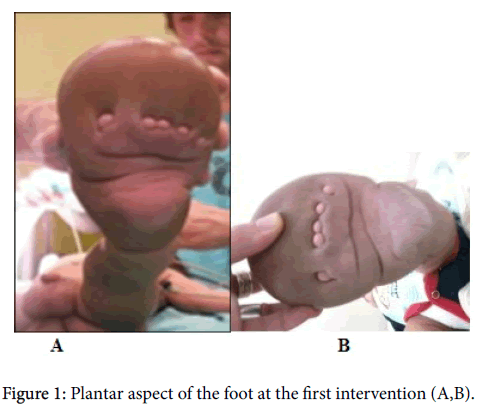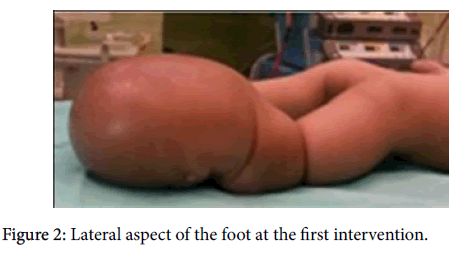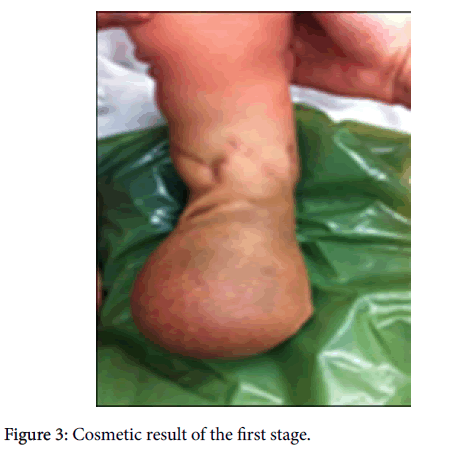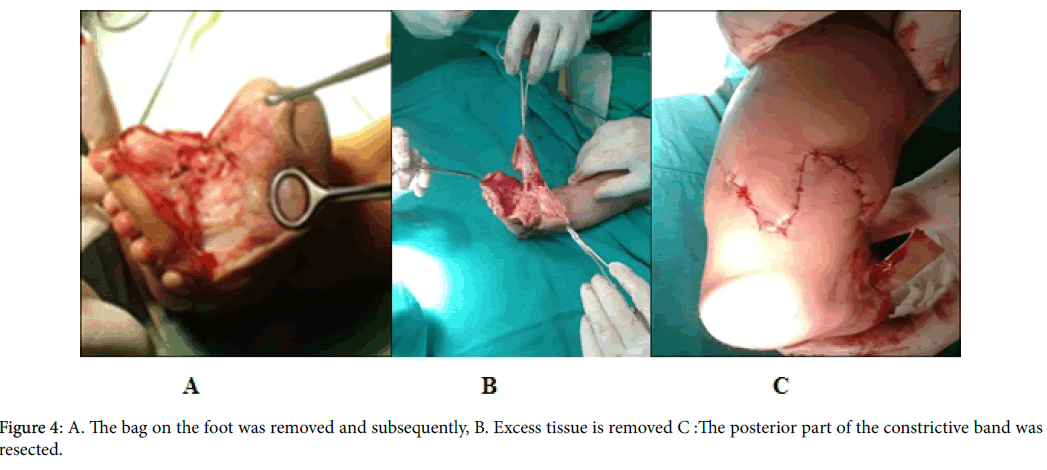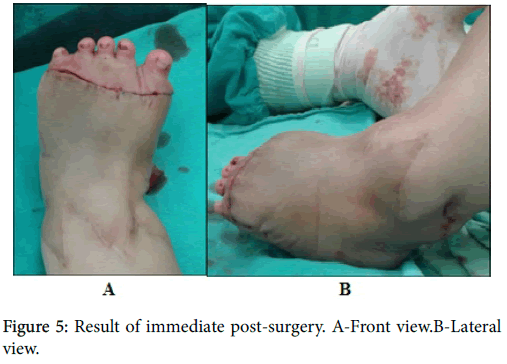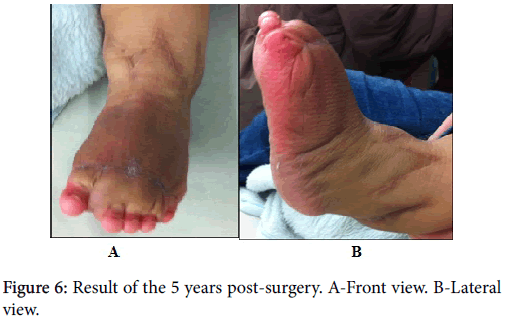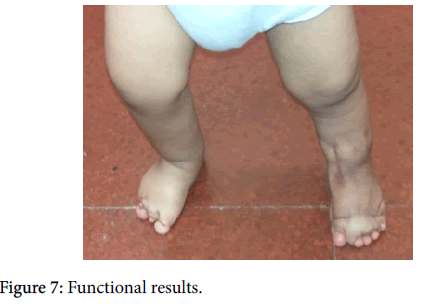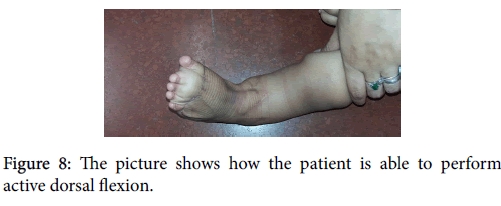Case Report Open Access
A Case Report of Active Amniotic Band Syndrome with Progressive Lymphedema Causing Vascular Insufficiency: Radical Excision of the Overgrown Tissue
Santiago Aleman and Bibiana Dello Russo*Department of Orthopaedics, Hospital Nacional de Pediatría “Juan P. Garrahan”, Buenos Aires, Argentina
- *Corresponding Author:
- Bibiana Dello Russo
Chief of Pediátricas Orthopaedics Clinic
Department of Orthopaedics
Hospital Nacional de Pediatría “Juan P. Garrahan”
Buenos Aires 1117, Argentina
Tel: 54-11-1544944896
Fax: 54-11-48078058
E-mail: bibianadellorusso@yahoo.com.ar
Received date: December 26, 2016; Accepted date: January 05, 2017; Published date: January 12, 2017
Citation: Aleman S, Russo BD (2017) A Case Report of Active Amniotic Band Syndrome with Progressive Lymphedema Causing Vascular Insufficiency: Radical Excision of the Overgrown Tissue. Clin Res Foot Ankle 5:224. doi:10.4172/2329-910X.1000224
Copyright: © 2017 Aleman S, et al. This is an open-access article distributed under the terms of the Creative Commons Attribution License, which permits unrestricted use, distribution, and reproduction in any medium, provided the original author and source are credited.
Visit for more related articles at Clinical Research on Foot & Ankle
Abstract
Introduction: Amniotic band syndrome (ABS) is an uncommon congenital anomaly characterized by multiple incapacitating manifestations. It may affect the bone, muscle, nerves, and vascular bundles according to the depth of the constriction band.
Material and methods: Here we present a 2-month-old infant patient with active ABS in the lower limb at risk for amputation, in which the constriction bands were released surgically using the extensive approach. A two-step surgery was performed. In the first step, a Z-plasty of the anterior portion of the proximal constriction band was performed. In a second step, the bag on the foot was removed and subsequently the posterior part of the constrictive band was resected.
Result: A follow-up of five years after surgery, respectively, revealed fully functional foot and restoration of blood supply.
Conclusion: This procedure allowed to establish normal circulation in the limb with active ABS after birth. Removal of the constriction band improves the distal tissue and avoids progressive deformity. Surgery of the SBA may be performed in one or two steps.
Introduction
Amniotic band syndrome (ABS) is an uncommon congenital anomaly characterized by multiple incapacitating manifestations. It may affect the bone, muscle, nerves, and vascular bundles according to the depth of the constriction band [1,2]. The main theory regarding the etiology of the syndrome is the premature rupture of the amniotic sac. Although the band does not modify, the growth of the child leads to worsening of distal fluid accumulation [3].
According to Paterson [4], the diagnosis the SBA should include at least two of the following diagnostic criteria:
Simple constriction ring; ring of
Constriction with distal deformity, with lymphedema or without it; fusion of distal parts
Congenital digital amputations.
Incidence in our country is 1:1,200 to 1:15,000 live births. Prevalence in spontaneous abortions 178 per 10,000. Prevalence in Latin America: 1:11,200 births. There is no predilection for sex or race (Proportion Male/female 1:1). There is no family predisposition or risk of recurrence. Despite correlated clinical evidence with the exogenous origin of the SBA, differential diagnosis is necessary some conditions that present phenotype similar but that are of genetic origin. In the "Michelin baby" syndrome or syndrome of the circumferential skin grooves multiple benign, are observed from the birth numerous rings of constriction in neck, forearms and legs which have as main characteristics the symmetrical distribution, absence of other malformations or amniotic flanges, benign evolution in the sense of spontaneous regression during childhood and familial character with autosomal transmission dominant. Adams-Oliver 21 is characterized by the absence of distal extremities of the legs and the fingers, with lesions in the scalp compatible with aplasia congenital skin, including bone defect underlying. The transmission of this condition is compatible with an autosomal pattern dominant. Although, they occur sporadically, the spectrum of syndromes. Oromandibular hypogenesis should also be considered. Congenital malformations involving the tongue (hypoglossy), the jaw (micrognathia) and the upper and lower limbs (hypodactyly or adactyly). It is admitted that the SBA does not involve risk of recurrence, although some were published.
Treatment, according to the constitutive findings of the syndrome, is surgery repair, plastic or orthopedic.
Lesions depend on the time of gestation in which it occurs the amnion rupture:
Early lesions: cranio-facial manifestations and more severe visceral diseases such as acrania, cephalocele, defects thoracoabdominals, cleft lip and palate.
Late lesions: constrictions, disruptions or amputations isolated from the extremities.
Transient oligoamnios explain deformations in the extremities or hyper angulation of the spine. The prognosis depends on the severity of the abnormalities. Intrauterine fetal treatment may be considered fetoscopic intervention may be useful to release the bands [5]. It would be indicated in cases where there is a risk of irreversible damage of extremity. The effectiveness of this method has not been proven and has defined the criteria for the selection of candidates for the intervention. Orthopedic treatment is based on tissue decompression to improve function and appearance of the limbs. However, there are also authors who prefer a 2-staged procedure as they are warning about vascular insufficiency. In literature there is no information about the enlargement of edema after birth or about the extensive removal of the skin excess and soft-tissue masses from the deformed limb with ABS. Here we present a patient with active ABS in the lower limb at risk for amputation.
Material and Methods
The patient was a 2-month-old infant presenting with progressive enlargement of the distal part of the foot associated with vascular insufficiency and lymphedema compatible with ABS. The Patterson classification was used on the initial to classify the grade. The ABS was classified as Patterson II [5]. A two-step surgery was performed. In the first step, a Z-plasty of the anterior portion of the proximal constriction band was performed [1] (Figures 1-3) in a second step, the bag on the foot was removed and subsequently the posterior part of the constrictive band was resected (Figure 4A). The removal of the overgrown tissues concerned both the subcutaneous lymphatic tissue and the skin. The procedure included a transverse incision on the dorsal aspect of the foot performed at the bases of the hallux and toes. Two incisions, perpendicular to the first one, also went along the dorsal aspect of the foot: the first one above the first and another one above the fifth metatarsal. In such a way a rectangular subcutaneous flap was formed that was separated from the basis in the proximal direction. The excess of the subcutaneous tissue was removed from the flap. The flap was also shortened by a measured value through tightening it and applying to incision line at the base of the toes (Figure 4B and 4C). In addition, decompression fasciotomy was performed. Before closing the wound, multiple skin incision was required on the dorsal aspect of the foot for suspected hematoma evacuation. A plantigrade foot was achieved and its function restored. Finally, the operated feet were slightly diminished in size in comparison with the contralateral.
Patterson classification
Simple ring constriction
Ring constriction accompanied by fusion of the distal bony parts, with or without lymphedema
Ring constrictions accompanied by fusion of distal parts or terminal syndactyly
Intrauterine amputations
Results
A plantigrade foot was achieved and its function restored. Finally, the operated feet were slightly diminished in size in comparison with the contralateral. This procedure allowed establishing normal circulation in the limb with active ABS with normal function (Figures 5 and 6). Currently the patient walks on his own without any neurovascular deficit (Figures 7 and 8).
Discussion
Contemporary, the concept of a 1-staged removal of constrictions conducted as early as possible is widely accepted. What is more, linear circumferential resection and closure rather than Z-plasties have been described as satisfactory in the literature. Our patient presented a constriction ring with distal deformity including atrophy and lymphedema (Patterson’s type 2). The process continued after birth.
Marek et al. considered, Patterson ´s classification does not reflect clinical features of patients because it does not take into consideration the dynamic aspect of the deformity [1]. He proposed the ABS deformity to be divided into stable and unstable/active deformity. The unstable or active ABS means that the tightening process continues after child’s birth. It should be emphasized that it is not the band that changes, it is rather the child that grows and consequently the band appears to become tighter. One-staged radical excision of the constrictions, together with debulking, that is, the removal of the skin flap with overgrown pathologic tissue, restored normal blood supply, and stopped progression of the deformity [6-9].
In our case with used two-stages excision with removal of fibrous groove and fasciotomy in the first step. On the second one the bag on the foot was removed and subsequently the posterior part of the constrictive band was resected with a good with good function and aesthetics of the operated leg.
Conclusion
This procedure allowed establishing normal circulation in the limb with active ABS after birth. Removal of the constriction band improves the distal tissue and avoids progressive deformity. Surgery of the ABS may be performed in one or two steps and should be performed as soon as it is possible.
References
- Napiontek M, Harasymczuk J (2015) Surgical treatment of active amniotic band syndrome (ABS) by Z-plasty and radical excision of the overgrowth tissue: A report of two cases with progressive lymphedema causing vascular insufficiency. J Pediatr Orthop 35: 16-18.
- Askins G, Ger E (1988) Congenial constriction band syndrome. J Pediatr Orthop8:461–466.
- Hall EJ, Johnson-Giebink R, Vasconez LO (1982) Management of the ring constriction syndrome: a reappraisal. Plast Reconstr Surg69:532–536.
- Patterson T (1961) Congenital ring constrictions. Br J Plast Surg 69:532–569.
- Muguti GI (1990) The amniotic band syndrome: single stage correction.Br J Plast Surg43:706–708.
- Javadian P, Shamshirsaz AA, Haeri S, Ruano R, Ramin SM, et al. (2013) Perinatal outcome after fetoscopic release of amniotic bands: a single-center experience and review of the literature. Ultrasound Obstet Gynecol 42:449–455.
- Wanter BG (1993) One-stage release of congenital circumferential constriction bands. J Bone Joint Surg75:650–655.
- Habenicht R, Hulsemann W, Lohmeyer JA, Mann M (2013) Ten-year experience with one-step correction of constriction rings by complete circular resection and linear circumferential skin closure. J Plast Reconstr Aesthet Surg66:1117–1122.
- Hung NN (2012) Congenital constriction ring in children: sine plasty combined with removal of fibrous groove and fasciotomy. J Child Orthop6:189–197.
Relevant Topics
Recommended Journals
Article Tools
Article Usage
- Total views: 8971
- [From(publication date):
March-2017 - Mar 29, 2025] - Breakdown by view type
- HTML page views : 7944
- PDF downloads : 1027

